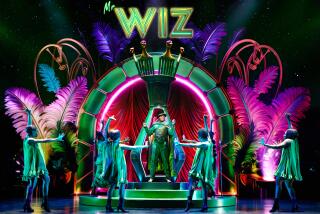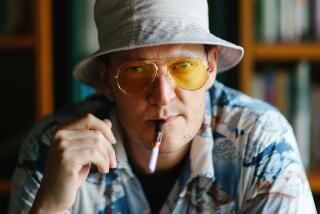Thoroughly Unmodern
LOS ANGELES â Twyla Tharp has some catching up to do. Even before she disbanded her modern dance company in 1988, her absorption with ballet had distorted its repertory and style, while her independent projects ever since have seemed curiously backdated and self-obsessed, irrelevant to the darkening landscape of American modernism.
âTharp!,â her new, two-year, 13-dancer touring venture, offers a major leap in choreographic quality from the disastrous Americana patched together for her âCutting Upâ tour with Baryshnikov three years ago. However, most of the three-part program at the Wiltern Theatre on Friday represented a reworking of ideas and formats sheâs recycled for the past 15 years. And nearly every choice regarding virtuosity and partnering remained balletic.
But perhaps only people with long memories or a good collection of bootleg videotapes will compare vintage Tharp to âTharp!â and judge the latter unworthy. Certainly, the Wiltern audience gave a standing ovation on Friday to âHeroes,â her return to the apocalyptic, confrontational m.o. of âFait Accompliâ (1983) and âIn the Upper Roomâ (1986).
Danced to a propulsive score by Philip Glass that uses themes by David Bowie and Brian Eno as material for expansion and development, âHeroesâ sets the whole company against Roger Jeffrey, Matt Rivera and Andrew Robinson, defining their heroism mostly through tests of endurance. The rest of the men assault them, nearly all the women entice them and Toshiko Oiwa keeps flinging herself at them as if they were statues ripe for demolition.
The heroesâ individual responses to such provocations provide the only complexity in the piece--that and a time scheme dramatized through costume changes. Obviously, the use of multiple protagonists cranks up the excitement, but not much else is new in âHeroes.â And it may be significant that nearly every other major choreographer of the â90s would reveal exactly what these heroes are fighting for and make it matter.
Not Tharp, however. No hint of social awareness disrupts the hermetically sealed dance narrative of either âHeroesâ or â66,â her latest pop suite, set to 11 recordings described in the program as âbachelor-pad music by Esquivel and others.â (The âothersâ include Cole Porter, but whoâs counting?)
Full of broad comedic strategies that Tharp has used in everything from the uneven but eventually sublime âCatherine Wheelâ (1981) to the incomprehensible âBumâs Rushâ (1989) and the worst parts of âCutting Up,â this overextended essay in whimsical Americana features a Santo Loquasto backdrop of the open road (seen from above) and two dancing automobile tires (one of them on pointe).
A hard-working five-dancer ensemble punctuates sequences for a battling couple (Julie Stahl and Robinson), a buoyant threesome (Gabrielle Malone, Todd Anderson and Rivera), plus an old man who relives his youth in a star solo that Shawn Mahoney canât yet take beyond diligence.
Tharp has called the work âcompletely autobiographical,â but itâs hard to spot any emotional connection to the characters who may represent her parents and siblings. Theyâre all just grist for the mill. Nor is there much spirituality in âSweet Fields,â her lyric abstraction of Shaker life, danced to hymns and Sacred Harp music.
However, Tharpâs painterly eye for figures in space, the flowing white Norma Kamali costumes and the pearly Jennifer Tipton lighting yield one gorgeous tableau after another, while the separation of the dancers by gender postpones until the very end any of the incredibly clumsy lifts that disfigure all three pieces. Even outrageously loud amplification (reportedly an opening night snafu) canât shatter the calm at the center of this very un-Tharpian proof of Tharpâs survival as a creative artist.
More to Read
The biggest entertainment stories
Get our big stories about Hollywood, film, television, music, arts, culture and more right in your inbox as soon as they publish.
You may occasionally receive promotional content from the Los Angeles Times.










